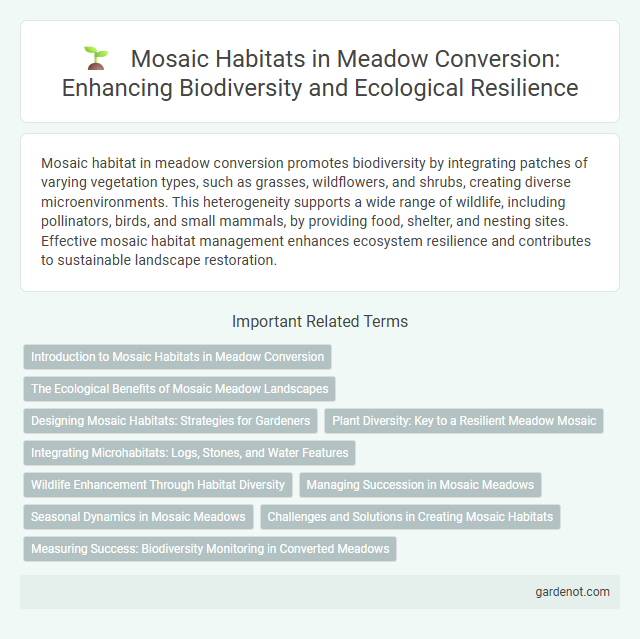Mosaic habitat in meadow conversion promotes biodiversity by integrating patches of varying vegetation types, such as grasses, wildflowers, and shrubs, creating diverse microenvironments. This heterogeneity supports a wide range of wildlife, including pollinators, birds, and small mammals, by providing food, shelter, and nesting sites. Effective mosaic habitat management enhances ecosystem resilience and contributes to sustainable landscape restoration.
Introduction to Mosaic Habitats in Meadow Conversion
Mosaic habitats in meadow conversion create diverse ecological niches by interspersing varied vegetation types, such as wildflowers, grasses, and shrubs, promoting biodiversity and resilience. These habitats enhance pollinator activity, support ground-nesting birds, and improve soil health through varied root structures. Incorporating mosaic patterns optimizes resource availability, microclimates, and species interactions within restored meadow ecosystems.
The Ecological Benefits of Mosaic Meadow Landscapes
Mosaic meadow landscapes create diverse habitats that support a wide range of pollinators, birds, and small mammals by offering varied plant species and flowering periods. This heterogeneity enhances soil health through varied root structures and organic matter, promoting nutrient cycling and water retention. These ecosystems also increase resilience to pests and climate extremes by maintaining balanced predator-prey relationships and microclimate variability.
Designing Mosaic Habitats: Strategies for Gardeners
Designing mosaic habitats involves creating a diverse array of plant types and structures to support a wide range of wildlife, including pollinators, insects, and small mammals. Gardeners should incorporate native wildflowers, grasses, shrubs, and seasonal variations to mimic natural ecosystems and enhance biodiversity. Strategic placement of flowering plants with overlapping bloom times optimizes nectar availability, while integrating sheltered areas provides essential nesting and overwintering sites.
Plant Diversity: Key to a Resilient Meadow Mosaic
Plant diversity in a meadow mosaic enhances ecosystem resilience by supporting a wide range of pollinators, herbivores, and soil microorganisms essential for nutrient cycling and habitat stability. Diverse native plants create microhabitats that buffer against environmental stressors such as drought and pests, promoting long-term ecological balance. Integrating a variety of grasses, wildflowers, and legumes optimizes seasonal blooms and root structures, strengthening the meadow's capacity to recover from disturbances and maintain biodiversity.
Integrating Microhabitats: Logs, Stones, and Water Features
Integrating microhabitats such as logs, stones, and water features into meadow conversions enhances biodiversity by providing essential shelter, breeding sites, and foraging opportunities for diverse wildlife species. These structural elements create mosaic habitats that support pollinators, amphibians, and small mammals, contributing to the ecological complexity and resilience of the ecosystem. Incorporating varied microhabitats improves soil health, moisture retention, and microclimates, promoting native plant growth and overall meadow vitality.
Wildlife Enhancement Through Habitat Diversity
Mosaic habitats created through meadow conversion significantly enhance wildlife diversity by providing a variety of microhabitats for different species. This habitat diversity supports numerous pollinators, small mammals, and birds by offering varied food sources, nesting sites, and shelter throughout the year. Maintaining structural complexity in meadows through staggered vegetation height and plant species diversity is crucial for promoting resilient ecosystems and boosting biodiversity.
Managing Succession in Mosaic Meadows
Managing succession in mosaic meadows enhances habitat diversity by maintaining a balance between grasses, wildflowers, and shrubs. Regular interventions such as selective mowing, grazing, or controlled burning prevent woody plant encroachment and promote a dynamic patchwork of vegetation stages. This approach supports a rich array of pollinators, ground-nesting birds, and small mammals, essential for ecosystem resilience and biodiversity conservation.
Seasonal Dynamics in Mosaic Meadows
Mosaic meadows exhibit complex seasonal dynamics characterized by shifts in plant species composition and flowering periods, promoting biodiversity through staggered resource availability. This temporal variation supports diverse pollinator communities by providing continuous nectar and pollen sources from spring through fall. Seasonal moisture gradients and microhabitats within mosaic meadows further drive habitat heterogeneity, enhancing ecosystem resilience and species richness.
Challenges and Solutions in Creating Mosaic Habitats
Creating mosaic habitats within meadow conversions faces challenges such as maintaining biodiversity while managing differing microclimates and soil conditions. Solutions involve adaptive planting strategies that incorporate native species diversity, rotational mowing schedules to support various wildlife, and soil amendments tailored to specific habitat patches. Integrating continuous monitoring and community engagement further enhances habitat resilience and ecological balance.
Measuring Success: Biodiversity Monitoring in Converted Meadows
Biodiversity monitoring in converted meadows is essential for evaluating the success of mosaic habitats, which combine diverse plant species to support wildlife. Regular surveys of flora and fauna, including pollinators, birds, and soil invertebrates, provide key data on ecosystem health and resilience. Quantitative metrics such as species richness, abundance, and habitat connectivity are critical indicators in assessing meadow restoration outcomes.
Mosaic habitat Infographic

 gardenot.com
gardenot.com